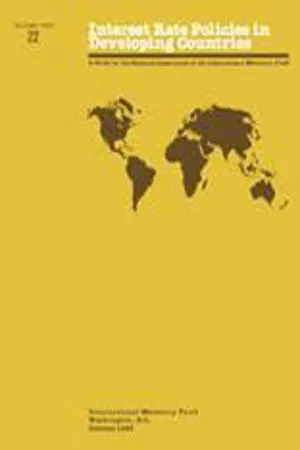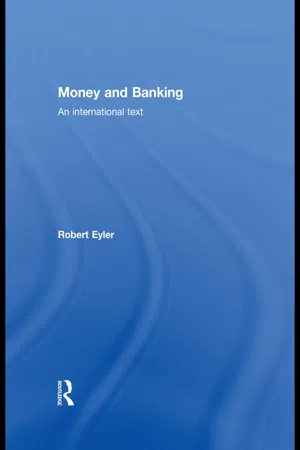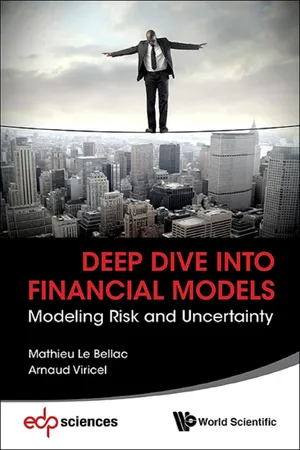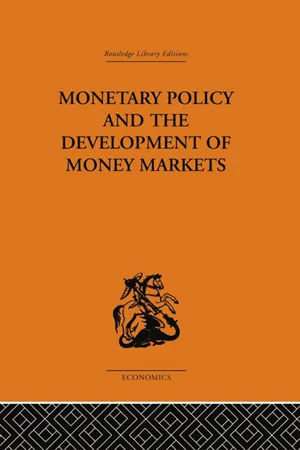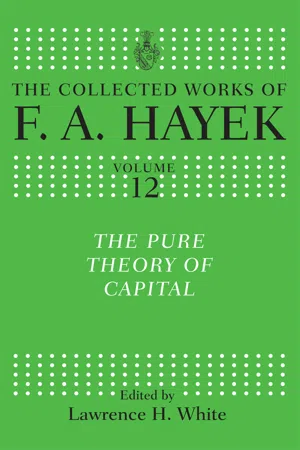Economics
Investment Interest Rates
Investment interest rates refer to the percentage return earned on an investment over a specific period. These rates are influenced by various factors, including inflation, central bank policies, and market demand. Higher interest rates generally indicate lower investment activity, while lower rates can stimulate investment and economic growth.
Written by Perlego with AI-assistance
Related key terms
7 Key excerpts on "Investment Interest Rates"
- eBook - ePub
- International Monetary Fund(Author)
- 1983(Publication Date)
- INTERNATIONAL MONETARY FUND(Publisher)
III Interest Rate Policies and Economic Growth
Interest rates can have a substantial influence on the rate and pattern of economic growth by influencing the volume and productivity of investment, as well as the volume and disposition of saving. This is especially true for countries where financial markets are relatively well developed or where private investment constitutes a significant share of total investment. Even in countries with less developed financial markets or in those where investment is overwhelmingly the responsibility of the public sector, interest rates may have a significant effect on the mobilization of household savings and on investment decisions. In analyzing this set of issues, it would be useful to distinguish between the effects on saving and those on investment, bearing in mind, however, that while the volume of new investment that can be undertaken is related to the amounts of both foreign borrowing and domestic saving out of current income, it is domestic saving that is by far the more important source of investment financing in most developing countries. Finally, both the savings and investment aspects of interest rate policies influence income distribution, which is treated in the last part of this section.Passage contains an image
Interest Rate Policies and Savings
A development strategy that relies on financial savings10 as a major source of investment finance requires price or nonprice incentives in order to stimulate saving in financial form and, where relevant, capital inflows. There is, however, considerable disagreement over the influence exerted by interest rates on the volume of saving: while an increase in interest rates may stimulate saving by making future consumption iess expensive relative to current consumption (substitution effect), it may also tend to reduce saving by lowering the amount of present saving necessary to buy a given amount of future consumption (income effect). The available empirical evidence on the relative importance of these two effects, based largely on the experience of Asian and Latin American countries, suggests that the substitution effect is more important than the income effect in developing countries, although not overwhelmingly so,11 - eBook - ePub
Islamic Money and Banking
Integrating Money in Capital Theory
- Iraj Toutounchian(Author)
- 2011(Publication Date)
- Wiley(Publisher)
Interest is basically determined in the money market because of its being speculated upon. There seems to be no doubt that explaining the forces which determine the interest rate has been one of the major problems facing economists. For the classical economists, the rate of interest (r) which prevails in the long run is determined exclusively by the thrift of the community, as indicated by its schedule of real saving (S), and the productivity of capital, as indicated by the schedule of demand for investment (I). Figure 2.1 shows the classical assertion on the determination of the interest rate. 2 Figure 2.1 Classical view on interest rate determination This fails completely to recognize that speculation is definitely a consequence of interest (rate). It was left to Keynes to draw the world's attention to the fact that interest is the main cause of speculation. It should be obvious to every economist that the internal rate of return (IRR) on any investment project has nothing to do with the rate of interest. In capitalist societies, investors use the rate of interest as the cut-off rate; to cut investment spending to the point wherever it comes into equality with IRR. This by no means implies that investment is a function of the rate of interest. This being the case, Figure 2.1 has to be amended accordingly, as shown in Figure 2.2. Figure 2.2 The true mechanism of interest rate determination and its likely impact on saving and investment In panel (a) speculative demand for money, M (d), and its intersection with the supply of money M (s), determines the rate of interest. The going rate of interest, (r*), might have an impact on investment schedule (I) in panel (b); but its impact on saving is certain. In a very special case, r* may coincide with the point of intersection of S and I. But be that as it may, it might correspond to excess demand for investment equal to c, as shown in panel (b) - eBook - ePub
Money and Banking
An International Text
- Robert Eyler(Author)
- 2009(Publication Date)
- Routledge(Publisher)
2 Interest rates and financial marketsIntroduction
Interest rates represent prices of every economic action because they represent both opportunity costs for the use of goods, services and inputs and connect time periods to each other. The sacrifice of consumption today must come with a reward, and consuming today must have its cost. There are many interest rates, one for every asset that exists. The “price” of an asset is in part determined by an interest rate. Interest rates are used in business plans to discount the future, as income to those who have deposited money, purchased stocks and bonds, and to those who make a loan. It is a cost to those who borrow, the cost of consuming more than you can afford at a given time. It is also the cost of not buying something that could produce income. We can summarize the interest rate’s definition generally in four ways:• The revenue from lending or not consuming; • The cost of borrowing or consuming; • The opportunity cost of holding money as cash; and • A measure of time preference concerning consumption.Interest rates come in many forms, all with the same basic set-up. An interest rate includes measures of risk, both general and very specific. When you borrow money, the rate at which you borrow is the nominal rate. This rate is the stated interest cost or return of a financial investment. There is also a real rate, but what separates the two? The difference between nominal and real variables in economics has to do initially with inflation, or purchasing power erosion, and other risks. In its most basic form, a nominal interest rate has the following equation:R = r + P(2.1) where R is a nominal rate, r is the associated real rate and P - eBook - ePub
Deep Dive into Financial Models
Modeling Risk and Uncertainty
- Mathieu Le Bellac, Arnaud Viricel(Authors)
- 2016(Publication Date)
- WSPC(Publisher)
The notion of inflation has not been addressed in this chapter while it would seem to be, at first sight, closely linked to interest rates. Inflation expresses the evolution of the value of money, and it is generally measured as the evolution of the number of monetary units necessary to buy consumer goods and services. Thus, it is a notion which links a world where the absolute reference is the monetary unit with a world where the reference is the ability to purchase goods and services. A positive inflation rate means that the value of money decreases with time, that is, with the same amount of money, the consumption opportunities decrease. The same logic implies that, if the interest rate of a financial investment is exactly equal to the inflation rate, the value of this investment expressed as a capability of consumption will be constant over time. This explains why inflation and interest rates may appear to be correlated. However, the two concepts are fundamentally different, and they may evolve in opposite directions. In fact, interest rates reflect the price of liquidity; in other words, interest rates account for the fact that we have at our disposal a sum of money today and not tomorrow. It is rather clear that even in a world without inflation, it is more interesting to use a sum of money right now rather than 10 years from now. Generally speaking, loans are subject to interests, even in the absence of inflation. The link between inflation and interest rates is known to exist, but is not systematic; economic theories which conceptualize those interactions lie beyond the classical scope of financial mathematics and will not be dealt with in this book.Although the concept of interest rate might appear intuitive, this first section shows that it uncovers in fact different meanings:The rate used to calculate the interests due by a borrower to its creditor is called interest rate for a retail loan but is called coupon when the debt is a bond. In this case, recall that the borrower is named issuer and the creditor is the bondholder.The rate used to calculate the present value of cash flows, that is today’s price of an amount of money to be received in the future, is the discount rate.The rate of return offered by a financial product on the market is its yield. We showed that the yield of a bond is the discount rate that should be used to calculate the market price of the bond.1.2Building the interest rates curveAt this point, we do not know how to compute in practice these interest rates: how can we determine the interest rates to be used in order to discount a cash flow? The observable quantities on financial markets are prices: prices of transactions on most exchange-traded markets are public; for example, one may access all the stock prices of the Dow Jones Index on the Internet. Bond prices are more difficult to obtain for individuals, but a large number of bonds are exchanged daily between financial institutions, with conditions that are disclosed to professional market participants. Thus, we can deduce the levels of interest rates from these reference bonds. Let us study the result of such an analysis on the Government bonds of Figure 1.2 - eBook - ePub
- Jagdish Handa(Author)
- 2002(Publication Date)
- Routledge(Publisher)
part sevenTHE RATES OF INTEREST IN THE ECONOMYPassage contains an image
chaptertwentyTHE MACROECONOMIC THEORY OF THE RATE OF INTERESTThe rate of interest is one of the endogenous variables in the Keynesian and classical models, so that its analysis is properly conducted as part of a complete version of those models. These were presented in Chapters 13 and 14.This chapter singles out the competing views on the determination of the rate of interest and focuses on their differences and validity. It also highlights the very important difference between the comparative static and the dynamic determination of the rate of interest.key concepts introduced in this chapter
• The Fisher equation of the nominal rate of interest• Stocks versus flows of funds• The loanable funds theory• The liquidity preference theory• The excess demand function for bonds• The dynamics of interest rate determination• The neutrality of money and inflation for the real rate of interestMacroeconomics avoids the bewildering array of interest rates on the numerous assets in the market by focusing on one single rate of interest, without completely specifying which rate of interest it is, as for example in the IS-LM model of Chapters 13 and 14 - J.S.G. Wilson(Author)
- 2013(Publication Date)
- Routledge(Publisher)
Moreover, in a capitalist (or quasi-capitalist) economy, investment opportunities rarely appear, unless surrounded by a penumbra of doubt and uncertainty. The expected rate of profit must take these risks and uncertainties into account and must exceed the interest rate by an amount sufficient to compensate for them. To the extent that the non-interest components of the discount variable outweigh the interest component, fluctuations in the interest rate will be of little importance. 41 Furthermore, even though we may assume that the entrepreneur aims at an ex ante equality between the rate of interest and the expected rate of profit, in a dynamic situation there need never be an ex post equality. Second, it will often happen that no two entrepreneurs will have access to financial resources on exactly the same terms. Not only is there a whole range of interest rates, but also a whole range of conditions which may be attached to a loan. In these circumstances, we found that for each investment project there tends to be one interest rate which is particularly relevant and, to the extent that the entrepreneur acts rationally, he will try to secure an equation at the margin between this rate and his expected rate of profit. So that the neat formula with which we started has now become greatly obscured and we are left with no more than a murky suspicion of what the final result will be in the real world of the businessman with its constant frictions, change and (one should add) irrationalities. For all that, there will still be traces of an underlying process, which no amount of distortion can completely eliminate.- eBook - ePub
- F. A. Hayek, Lawrence H. White(Authors)
- 2019(Publication Date)
- Routledge(Publisher)
et seq. [Oskar Lange (1904–1965) taught at the University of Chicago (1937–45) before returning to his native Poland as an advisor to the post-war Stalinist government. Besides his work on interest and business cycle theory, he famously argued in the socialist calculation debate for the superiority of ‘market socialism’, a state-owned economy that guides production by having central planners intelligently set ‘accounting prices’ against which factory managers and other functionaries will optimise. Mises and Hayek took the contrary position that real market competition among private resource owners is necessary to generate accurate prices for capital goods and establish a rational allocation of resources.—Ed.]Passage contains an image Twenty-Seven Long-Run Forces Affecting the Rate of Interest
Having considered in the last chapter the impact effect of any change in investment demand, we must now turn to the further repercussions of the changes we have observed. We have seen that, in a money economy, one of the effects of a change in the profitability of investment will be a release of money from (or an absorption of money into) idle balances and a consequent change in the size of the money stream which meets the stream of goods.1 We have not yet considered the effects on returns of this change in the money stream, since they will make themselves felt only after the short period with which we were concerned in the last chapter.Influences Determining the Shape of the Investment Demand CurveThe returns curve or investment demand schedule which then we treated as a given magnitude, or as an independent variable, will clearly be affected by changes in the size of the money stream. Before we can analyse these effects it will be necessary to make a somewhat closer examination of the factors which determine the shape of this curve in general, and at the same time to distinguish between the different ways in which the amount of investment can change and the effects of such changes on the returns curve.
Index pages curate the most relevant extracts from our library of academic textbooks. They’ve been created using an in-house natural language model (NLM), each adding context and meaning to key research topics.
